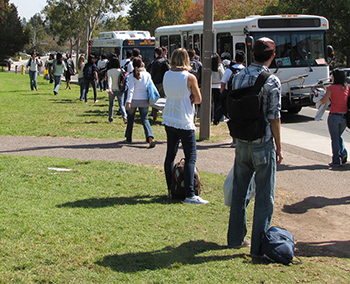By John Addison (updated 4/3/09). Like all great universities, the University of California at San Diego, must either spend millions for car parking or spend millions for improved transportation. Using transportation demand management, UC San Diego is spending millions less in both areas.
27,500 students attend the university. “We encourage commuters to use alternate forms of transportation,” said Brian d’Autremont, TPS director. “Approximately 43 percent of UC San Diego commuters use some form of alternative transportation, including, bikes, buses, trains and vanpools.” In addition, last fall UC San Diego reduced the number of single occupancy vehicles on campus by 800 cars.
UC San Diego uses AlterNetRides as a platform, making it easy for staff and students to be matched with the van pool or carpool that best meets their destinations and schedules. Use of HOV lanes and access to preferred parking make shared rides considerably faster. Zipcar on campus makes cars available by the hour, helping students avoid the need for owning a car.

In 2006, UC San Diego doubled the number of people riding buses on campus. A key to this growth was establishing the best routes and schedules. UC San Diego uses realtime tracking and demand management software to do this. The University uses a hosted customized application from Syncromatics, which performs realtime tracking with GPS and cellular communication to determine the location and speed of each bus.
The system develops a database showing the number of passengers at any stop at anytime. By querying the database, routes and schedules can easily be adjusted. UC San Diego’s Director Brian d’Autremont summarized, “Syncromatics’ system has saved us over one million dollars in fiscal year 2006, after being installed for just a little over 6 months. We typically buy 5 buses each summer, this year we were able to increase the effectiveness of our system enough that we didn’t have to buy any. The system paid for itself several times over in bus, fuel and driver costs, while increasing our ridership and improving customer service ratings dramatically.
Another big payoff of UC San Diego’s alternative transportation is a reduction in needed parking spaces. Each spot in a parking structure costs the university $22,000 to $29,000.
More people will ride on transit if they know how to get to their destination and if long waits are not necessary. The Syncromatics realtime tracking system which integrates with Google Maps to show actual bus locations on an LCD in the student lounge, on arrival signage, on mobile devices, and even in text messages. Ridership continues to grow.Realtime Display
Information technology is becoming invaluable in making transportation efficient as well as appealing to more riders. Fleet managers can now implement custom applications and realtime services without investing in hardware, software, and hiring specialized technologists. Hosted applications such as Syncromatics and AlterNetRides are run by the service provider. Middleware such as XML and Java allow these applications to be integrated with databases, billing systems, and other fleet applications.

UC San Diego is supporting energy independence and climate solutions by encouraging clean transportation. The university fleet also is becoming more fuel efficient. Over time, the university’s 50-plus buses will be converted to hybrid CNG, reducing their emissions. The University is also purchasing 225 electric vehicles and 32 hybrid vehicles for its fleet.
The importance of climate solutions is integral to the institution. UC San Diego evolved from the Scripps Institute of Oceanography under the leadership of Roger Revelle, who with Charles Keeling first measured the growing atmospheric concentration of CO2. Revelle College is one of six of the university’s colleges. The National Academy of Sciences recognizes UC San Diego as one of the top ten science universities in the nation. Professors include Nobel Laureates Paul Crutzen and Mario Molina whose chemistry research with Sherwood Rowland lead to the discovery of the ozone hole and the Montreal Protocol.
The University of California has made a system-wide commitment to reduce carbon emissions, energy consumption and reliance on imported fossil fuels. The University supports and adheres to the UC Policy on Green Building Design, Clean Energy Standard, and Sustainable Transportation Practices.
Universities and Colleges are leading in many areas of transportation demand management. An encyclopedia of best practices is available at the Victoria Institute.
John Addison will speak at U.C. San Diego on April 14, 2009 at the UC San Diego Ride Clean Expo. John Addison’s new book – Save Gas, Save the Planet – is available at the UC San Diego Bookstore and other booksellers.
